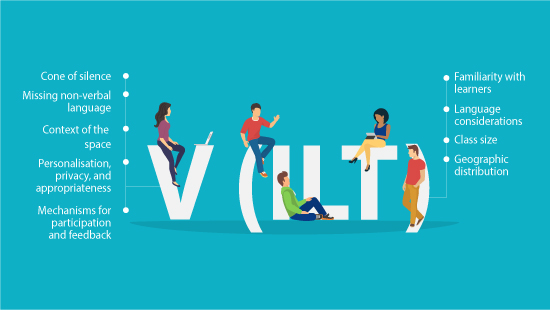(If you’re new to this series, here is some brief background to help you catch up:
Given the unique training challenges that the COVID-19 pandemic poses for us all, this series explores the various considerations for delivering an effective VILT (Virtual Instructor-Led Training). I recommend that you read the first two posts in sequence, and then, you can even pick and choose what’s of greater relevance to you.
Whenever you’re in the middle of making decisions about training, it’s a good idea to step back and consider your learners specifically. Very often, institutional constraints, business realities, and practical compromises end up gradually erasing the learner from the picture: naturally, this spells disaster for the ultimate success of the program. If you want to change learner behaviour and have a real impact on performance, the person who is actually performing those tasks cannot be left too far behind in the race of competing needs! (Of course, if you are only looking at a checkbox training deployment to fulfil on-paper compliance, this matters far less…)
So, in our deliberations on whether VILT is a good option — and when it is a good option — let’s turn our focus to the learner.
There are some things that we anyway consider when thinking about conducting an ILT (instructor-led training). Now, there are just a few more aspects we suggest tagging on because of the “V” of the VILT mode of delivery.

We’ll begin with the more familiar paradigm of ILTs and then see what VILT further layers on those initial considerations.
Familiarity with Learners
Every trainer knows that the quality of interaction and the level of engagement in a classroom session depends to some extent on how well the trainer knows the audience being trained. If the two parties are new to each other, you invariably have to carve out a little warm up time explicitly and implicitly. Explicitly is in the sense that you will have icebreakers and kick-off discussions, to get everyone used to each other. Implicit in the sense that you will not launch into the core content or pick an aspect driven by discussion or intense activity – rather, you will start off light and easy.
This is true of any classroom; it is doubly true of a VILT. The only thing is, as we saw before, there may be a challenge in terms of making that design trade-off between getting your learners comfortable with the dynamics of participation vs. making as brief a session as possible.
Language Considerations
Always, with a synchronous medium, the learner has to keep up with the pace at which a session moves. If there happens to be a multilingual audience, any of whose primary language is not the medium of instruction, the facilitator has to strike an average so that native speakers are not disengaged and non-native speakers are not left behind. This is true for both ILTs and VILTs.
Class Size
Well, definitely the number of people you can accommodate in a classroom session is something to think of! But even if you discount a mob, you do have to think of the class size in relation to the content. There are some kinds of role-plays or activities that are necessary from a content perspective, but viable only for certain numbers of people. Just to be totally clear, I am not implying a blanket rule for role-plays in general – I am talking about the number of roles in a role play varying based on the content of each training!
Most times the digital medium itself means that many of these conventional activities will be ruled out. Okay, in that case, if you’re anyway adapting the design in that manner and ruling out these tricky parts of the training… are you in the clear? I’m afraid not. For example, you need to consider how many attendees at a time your platform will support.
Geographic Distribution
Of course, the more spread out your learners are, the more challenging it is to run a classroom session. Do you run a Train the Trainers series and scale up local capacity to run the program, is it something better done by one central team…? The answer could depend on a lot of other contributory factors, but essentially, this is a factor to think of.
It’s also quite obvious to associate this with a classroom training – there is also the logistical aspect of getting everyone to one place, right? Surely in the digital, work-from-home world we are in now, this shouldn’t matter for VILTs? Actually, it still does. We need to consider time zone differences because of the synchronicity of the medium. You would really struggle to work out a training time for combinations like SE Asia and South America, or the US and China!
The solution may therefore require multiple deployments catering to each time zone cluster.
So, these aspects we have considered up to now matter to any instructor-led session, physical or virtual.
What further implication does the ‘V’ of the VILT have for us?
Cone of Silence
Everyone in your audience attending your session should be able to do so within a ‘cone’ of silence at home. In our current world of ad hoc work-from-home arrangements and no childcare or domestic help and support, this is asking for a lot (if not the impossible!) from many. The training coordinator can only control managers and say “Free this person to focus on this training” — they cannot run interference with the learner’s 5-year old child, spouse, siblings, elderly parents, etc. and carve out dedicated and uninterrupted time to attend the training!
Missing Non-verbal Language
Anyone who has conducted even a one-hour training session knows how much we rely on being able to read facial expressions and body language as part of effective facilitation. There are many who hesitate to speak up and say they don’t understand something/ have a question. These cues are what tell us to stop and encourage the participant to speak up. Now, learners have an even more impersonal medium to cope with, and one in which participation is always less than face-to-face in a classroom. (And, Zoom fatigue is real, people!) So consider the effect of such a changed session dynamic on your learners and see if you might even need to consider support mechanisms to get learners to still engage effectively with the session, trainer, and content.
Context of the Space
Nobody needs an explanation of how distracting our personal devices can be when we are trying to work. Notifications and messages so successfully sabotage our concentration while we’re working to the point that a whole slice of the self-help and productivity industry is dedicated to solving this issue!
Now, many of our learners may be logging into work from personal devices. The separation of ‘space’ from personal life brought about by using a work machine, just disappeared. This has to be addressed and accounted for by facilitators and training coordinators. In a classroom training, you can still walk around and gauge who is looking at their work/personal phone a bit too much during the session. But with the virtual, distributed classroom – that is impossible. And it may not be a wilful disengagement from the session, even work (incessant mails, texts from up or down the line) can keep interrupting focus during training. We need to find ways to help learners manage these distractions.
Personalisation, Privacy, and Appropriateness
Our expectations for how employees conduct themselves need to change significantly, sometimes reasonably and sometimes less so. As we saw earlier, there have been lapses in conduct that range from understandable to inexplicable. Facilitators and learners alike have to be mentally prepared for the new normal. Facilitators particularly will have to moderate, and respond effectively to a whole new set of situations, even ones that have nothing to do with the training itself but impact the delivery and flow of the session all the same.
There is also a certain level of tech-savvy that facilitators need to acquire. (There is nothing worse than a facilitator who appears outdated — and hence incompetent! — about what’s happening with the platform.) For example, as we have seen with Zoom, anyone can later access a “private” session chat between two participants, rendering it not private at all. Think about the company confidential information that can be leaked as a result of perfectly natural, relevant exchanges between learners during a training! And that ‘Zoom-bombing’ has been added to our lexicon tells you just how much of a problem it is and how prevalent a phenomenon.
Mechanisms for Participation and Feedback
It’s not at all difficult to set up appropriate mechanisms to address the increased support that learners may need to be able to switch to a VILT-driven delivery format, but it does take a little thought and effort. L&D and facilitators have to coordinate and brainstorm to come up with effective solutions.
Similarly, even in-session and post-session feedback collection has to be handled differently for VILTs as compared to ILTs, needing perhaps a slightly different kind of organisation and collation.
Looking to Go Virtual?
Talk to our Digital Learning Experts to understand how can we help you transform your ILTs to Digital Learning quickly and on a budget. Or write to us at elearning@upsidelearning.com




















2 Replies to “Focusing on Audience”
Valuable collection its really help to me….
Valuable collection its really help to me….